

Strategos is a military wargame developed by Charles A. L. Totten for the United States Army, and published in 1880.


Strategos is a military wargame developed by Charles A. L. Totten for the United States Army, and published in 1880.
Jon Peterson identifies Strategos as being largely descended from the Prussian Kriegsspiel , and its translations, that had made their way into the hands of British military officers in the 1870s. [1]
Strategos was meant to be a training tool at various levels, starting with introductory scenarios and working toward more complex and advanced ones. This was contrasted with other forms of kriegsspiel which were cast as being primarily for those in elite military leadership. An article in the Army and Navy Journal, from November 25, 1882, describes the role and function of the Strategos game in contrast to William R. Livermore's publication of a more traditional The American Kriegsspiel (1882), as follows: [2]
We have offered to us two American games — those of Messrs. Totten and Livermore. Mr. Totten's has the advantage of priority of publication, and is claimed to be based on military principles and to be an assistant both to the young and old student, that by its means one can wheel a set of fours and manoeuvre a great army. The War Department, by issuing the book to companies, inferentially approves it.
Strategos consists of two different games. The Battle Game was played on a board, whereas the Advanced Game was played on maps and miniature terrain. [3]
In Strategos, Totten leans toward the "free" kriegsspiel movement in allowing the referee discretion in matters not covered by the normal game rules. [1] Peterson identifies the free kriegsspiel movement with Klemens Wilhelm Jacob Meckel's work Studien über das Kriegsspiel, along with other Prussian authors of the 1870s and later. [1]
The Battle Game owes more of its heritage to chess, and resembles the wargame of Johann Christian Ludwig Hellwig. [3]
The Advanced Game relies on the referee to provide a scenario to the two sides, which are colored red and blue. Orders are provided in writing, and three topographic maps may be used: one for the referee, and one for each side. The referee map is the master copy with all information, whereas the player maps show only what is known to the respective side. Blocks are used for troop formations, and are scaled to the size of those formations on the topographic maps. [3]
When there are conflicts in the game, the referee calculates probabilities, and then dice and tables are used to determine the outcomes. In more traditional kriegsspiel games, the referee would roll all the dice privately, and provide the relevant battlefield report. However, in Totten's Strategos, the players roll the dice openly and consult the necessary table, such as Table T, for combat resolution. [3]
While Strategos was reiterating common practices and trends in 19th century wargaming, these systems largely fell into obscurity in the 20th century. In 1967, Strategos was rediscovered by David Wesely at the University of Minnesota library. An avid hobby wargamer and reader of wargaming literature, Wesely seized upon these rules and incorporated their principles into the miniature wargames played by the Midwest Military Simulation Association (MMSA). These included the role of the referee, and the principle of free kriegsspiel that players could attempt anything, although not always successfully, and that the referee should be able to make judgements to cover anything not ordinarily covered by the rules. [1] Totten's Strategos became the cornerstone text for the Twin Cities gamers. [4] The incorporation of Totten's Strategos into MMSA wargaming culminated with the 1968 development of Strategos N, a compact set of Napoleonic wargaming rules devised by Wesely and other MMSA members. These rules were eventually published in 1970. [1]
Dave Wesely developed Strategos N as the first MMSA Strategos variant for the first time in 1968. It was later self-published in 1970, and again in 1984. [5]
Dave Arneson developed Strategos RT for his Russo-Turkish wargames campaign, and the rules circulated in draft form in 1969. [5]
Dave Wesely developed Strategos C for wargames set during the American Civil War, and it circulated in draft form in 1969, acting as a precursor to Valley Forge (1976). [5]
Dave Arneson and Randy Hoffa developed Strategos A in 1969, for wargames set in the ancient period. [5]
Numerous games developed by the MMSA adapted rules from Strategos, such as its Table T, for combat resolution. These games include Don't Give Up the Ship! , Dungeon! , and Valley Forge. [6]
The concept of the referee in Totten's Strategos led to Dave Wesely expanding upon these ideas to create the Braunstein games, which were influential in the early history of role-playing games. [7] This development of the role of the referee became a catalyst for the evolution of role-playing games. [8]
According to some analyses, the early mass combat battles in Blackmoor , as detailed in The First Fantasy Campaign (1977), were based on Strategos rather than Chainmail . [9]

A wargame is a strategy game in which two or more players command opposing armed forces in a simulation of some military operation. Wargaming may be played for recreation, to train military officers in the art of strategic thinking, or to study the nature of potential conflicts. Many wargames re-create specific historic battles, and can cover either whole wars, or any campaigns, battles, or lower-level engagements within them. Many simulate land combat, but there are wargames for naval and air combat, as well.
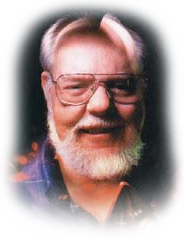
David Lance Arneson was an American game designer best known for co-developing the first published role-playing game (RPG), Dungeons & Dragons, with Gary Gygax, in the early 1970s. Arneson's early work was fundamental to the role-playing game (RPG) genre, pioneering devices now considered to be archetypical, such as cooperative play to develop a storyline instead of individual competitive play to "win" and adventuring in dungeon, town, and wilderness settings as presented by a neutral judge who doubles as the voice and consciousness of all characters aside from the player characters.

Blackmoor is a fantasy role-playing game campaign setting generally associated with the game Dungeons & Dragons. It originated in the early 1970s as the personal setting of Dave Arneson, the co-creator of Dungeons & Dragons, as an early testing ground for what would become D&D.
The fog of war is the uncertainty in situational awareness experienced by participants in military operations. The term seeks to capture the uncertainty regarding one's own capability, adversary capability, and adversary intent during an engagement, operation, or campaign. Military forces try to reduce the fog of war through military intelligence and friendly force tracking systems.
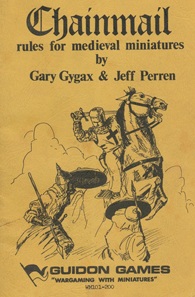
Chainmail is a medieval miniature wargame created by Gary Gygax and Jeff Perren. Gygax developed the core medieval system of the game by expanding on rules authored by his fellow Lake Geneva Tactical Studies Association (LGTSA) member Jeff Perren, a hobby-shop owner with whom he had become friendly. Guidon Games released the first edition of Chainmail in 1971.

The history of role-playing games begins with an earlier tradition of role-playing, which combined with the rulesets of fantasy wargames in the 1970s to give rise to the modern role-playing game. A role-playing game (RPG) is a type of game in which the participants assume the roles of characters and collaboratively create stories. Traditionally all the participants but one take on characters and determine the actions of their characters based on their characterization and the actions succeed or fail according to a system of rules and guidelines, and one of the participants takes on the role of game master who narrates the story, plays all the non-player characters and determine the challenge rating and the outcome of various actions. Within the rules, the participants may improvise freely; their choices shape the direction and outcome of the games.

Kriegsspiel is a genre of wargaming developed by the Prussian Army in the 19th century to teach battlefield tactics to officers. The word Kriegsspiel literally means "wargame" in German, but in the context of the English language it refers specifically to the wargames developed by the Prussian army in the 19th century. Kriegsspiel was the first wargaming system to have been adopted by a military organization as a serious tool for training and research. It is characterized by high realism, an emphasis on the experience of decision-making rather than on competition, and the use of an umpire to keep the rules flexible and manage hidden information. After Prussia's impressive victory over France in the Franco-Prussian War, other countries began designing similar wargames for their own armies.

Don't Give Up the Ship is a set of rules for conducting Napoleonic era naval wargames. The game was published by Guidon Games in 1972 and republished by TSR, Inc. in 1975. The game was developed as a collaboration between Dave Arneson, Gary Gygax, and Mike Carr. It was the first collaboration between Dave Arneson and Gary Gygax, the co-authors of Dungeons & Dragons. Mike Carr edited the rules and researched the historical single ship actions that are included as game scenarios.
David Wesely is a wargamer, board game designer, and video game developer. Wesely's developments, inspired by Kriegsspiel wargames, were important and influential in the early history of role-playing games.
The Midwest Military Simulation Association (MMSA) is a group of wargamers and military figurine collectors active during the late 1960s and 1970s.

Siege of Bodenburg is a wargame developed in 1967 by Henry Bodenstedt. It is one of the earliest sets of rules for conducting battles with medieval miniatures.

The Castle & Crusade Society was a chapter of the International Federation of Wargaming dedicated to medieval miniature wargaming.

Robert J. Kuntz is a game designer and author of role-playing game publications. He is best known for his contributions to various Dungeons & Dragons-related materials.
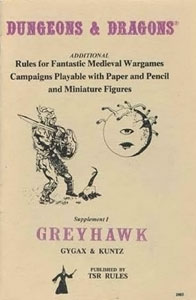
Greyhawk is a supplementary rulebook written by Gary Gygax and Robert J. Kuntz for the original edition of the Dungeons & Dragons (D&D) fantasy role-playing game. It has been called "the first and most important supplement" to the original D&D rules. Although the name of the book was taken from the home campaign supervised by Gygax and Kuntz based on Gygax's imagined Castle Greyhawk and the lands surrounding it, Greyhawk did not give any details of the castle or the campaign world; instead, it explained the rules that Gygax and Kuntz used in their home campaign, and introduced a number of character classes, spells, concepts and monsters used in all subsequent editions of D&D.

Blackmoor is a supplementary rulebook of the original edition of the Dungeons & Dragons fantasy role-playing game written by Dave Arneson.
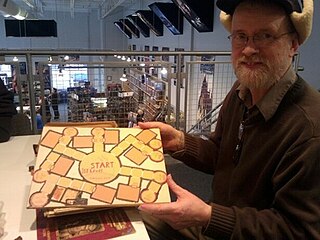
David R. Megarry is a game designer most notable for the board game Dungeon!.
Braunstein is an experimental game and game genre introduced by David Wesely, a member of the Midwest Military Simulation Association, in the late 1960s, and originally played in the Twin Cities. Braunstein was important and influential in the early history of role-playing games.
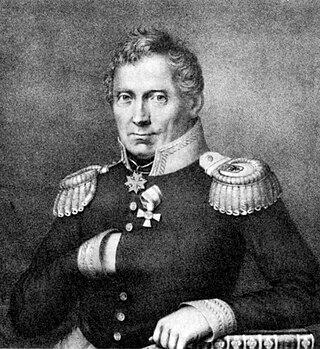
Georg Heinrich Rudolf Johann von Reisswitz (1794–1827) was a Prussian army officer. Reisswitz is regarded by many as the father of wargaming, as he developed the first wargaming system to be widely used as a serious tool for training and research. The particular genre of wargaming he developed is known in the English-speaking world as Kriegsspiel. It is characterized by high realism, an emphasis on the experience of decision-making rather than on competition, and the use of an umpire to keep the system flexible.

A wargame is a strategy game that realistically simulates warfare. Wargames were invented for the purpose of training military officers, but they eventually caught on in civilian circles, played recreationally.
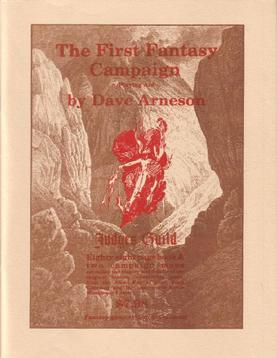
The First Fantasy Campaign is a supplement for fantasy role-playing games written by Dave Arneson and published by Judges Guild in 1977.